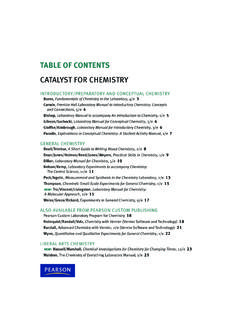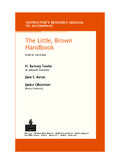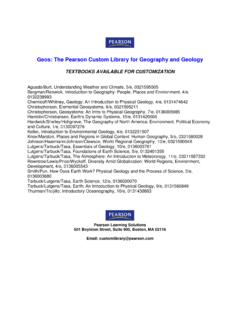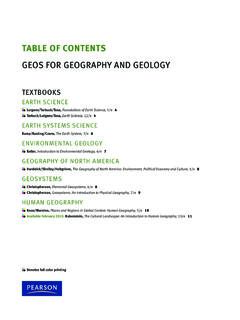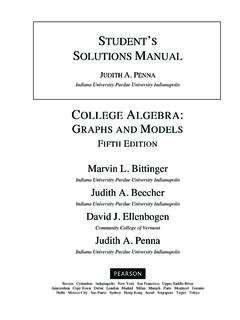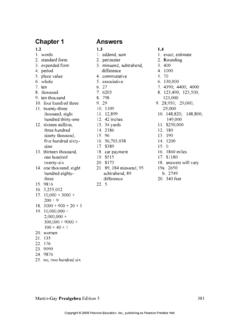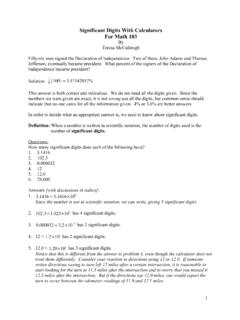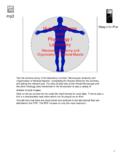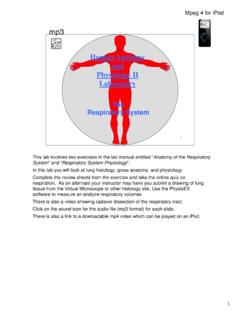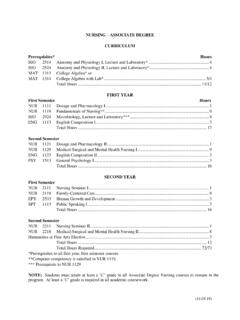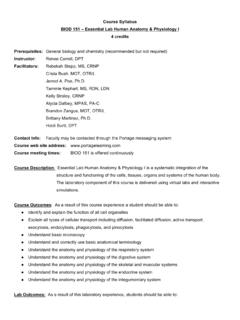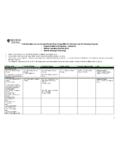Transcription of INTRODUCTORY AND HUMAN BIOLOGY - Pearson
1 INTRODUCTORY and HUMAN Biology3 INTRODUCTORY AND HUMAN BIOLOGYThe Scientific Method12 PHSYM0544 Cells and Energy14 PHSYM0545 Nutrition and Metabolism8 PHSYM0546 Mitosis12 PHSYM0547 Meiosis and Genetics14 PHSYM0548 DNA Structure, Synthesis, and Fingerprinting10 PHSYM0549 Transcription, Translation, and Genetically Modified Organisms10 PHSYM0550 The Theory of Evolution14 PHSYM0551 Natural Selection10 PHSYM0552 Species and Races16 PHSYM0553 Biodiversity16 PHSYM0554 Population and Ecosystem Ecology12 PHSYM0555 Community Ecology and Conservation Biology12 PHSYM0556 Gender Differences and Athleticism6 PHSYM0557 Fertilization, Birth Control, and Sexually Transmitted Diseases6 PHSYM0558 The HUMAN Nervous System12 PHSYM0559 Plant Structure and Function12 PHSYM0560 Borden/BelkScience for Life Laboratory Manual, 2/e 2007, 0-13-188804-8 Accompanies: Belk/Borden/Maier, BIOLOGY : Science for Life, 3/eBelk/Borden/Maier, BIOLOGY : Science for Life with Physiology, 3/ePage CountLab CodeINTRODUCTORY AND HUMAN BIOLOGYI ntroduction to the Scientific Method22 BCSYM0901 Interdependence Among Organisms16 BCSYM0902 Windows to a Microscopic World24 BCSYM0903 Functions and Properties of Cells14 BCSYM0904 Movement of Molecules Across Cell Membranes18 BCSYM0905 Investigating Cellular Respiration20 BCSYM0906 Organic Molecules and Nutrition16 BCSYM0907 Factors that Affect Enzyme Activity16 BCSYM0908 Functions of Tissues and Organs I22 BCSYM0909 Functions of Tissues and Organs II22 BCSYM0910 Bres/WeisshaarThinking About BIOLOGY : An INTRODUCTORY Laboratory Manual, 3/e 2008, 0-13-230736-7 Page CountLab CodeDenotes 4-color laboratory manualIntroduction to Anatomy.
2 Dissecting the Fetal Pig22 BCSYM0911 Organs of the Abdominal Cavity26 BCSYM0912 The Circulatory System22 BCSYM0913 Introduction to Forensic Biology22 BCSYM0914 Mitosis and Asexual Reproduction18 BCSYM0915 Connecting Meiosis and Genetics38 BCSYM0916 HUMAN Genetics22 BCSYM0917 Introduction to Molecular Genetics24 BCSYM0918 Biotechnology: DNA Analysis30 BCSYM0919 Using Biotechnology to Assess Ecosystem Damage18 BCSYM0920 Population keyword search: symbiosis4content and availability subject to changeSYMBIOSIS FOR THE BIOLOGICAL SCIENCESBres/WeisshaarUnderstanding HUMAN BIOLOGY : Laboratory Exercises, 2/e 2007 0-13-179009-9 Accompanies: Goodenough/McGuire/Wallace, BIOLOGY of Humans: Concepts, Applications, and Issues, 3/ePage CountLab CodeContinued Bres/WeisshaarThinking About BIOLOGY : An INTRODUCTORY Laboratory Manual, 3/e 2008, 0-13-230736-7 Page CountLab CodeIntroduction to the Scientific Method22 BCSYM1060 Using the Compound and Dissecting Microscopes24 BCSYM1061 Functions and Properties of Cells26 BCSYM1062 Investigating Cellular Respiration20 BCSYM1063 Enzyme Activity16 BCSYM1064 Food Analysis and Choices for Good Health20 BCSYM1065 The Skin: Example of an Organ System22 BCSYM1066 The Musculoskeletal System22 BCSYM1067 Examination of Skeletal Structure22 BCSYM1068 The Nervous System18 BCSYM1069 Introduction to Forensic Biology22 BCSYM1070 The Circulatory System24 BCSYM1071 Introduction to Anatomy.
3 Dissecting the Fetal Pig22 BCSYM1072 Organ Systems in the Abdominal Cavity26 BCSYM1073 The Reproductive System28 BCSYM1074 Mitosis and Asexual Reproduction20 BCSYM1075 Connecting Meiosis and Genetics40 BCSYM1076 HUMAN Genetics24 BCSYM1077 Introduction to Molecular Genetics24 BCSYM1078 Biotechnology: DNA Analysis30 BCSYM1079 Using Biotechnology to Assess Ecosystem Damage18 BCSYM1080 Preface4 BCSYM0113 The Process of Scientific Inquiry28 BCSYM0114pH and Buffers24 BCSYM0115 Macromolecules24 BCSYM0116 Using the Microscope24 BCSYM0117 Enzymes22 BCSYM0118 Cellular Respiration32 BCSYM0119 Photosynthesis24 BCSYM0120 Chromosomes and Cell Division28 BCSYM0121 Mendelian Genetics24 BCSYM0122 Forensic Application of Molecular Genetics20 BCSYM0123 Microorganisms and Disease28 BCSYM0124 Plant Diversity24 BCSYM0125 Animal Diversity 36 BCSYM0126 Digestion24 BCSYM0127 Circulation24 BCSYM0128 The Sensory System34 BCSYM0129 Plant Structure24 BCSYM0130 Flowers, Fruits.
4 And Seeds24 BCSYM0131 Animal Behavior24 BCSYM0132 Foraging Strategy24 BCSYM0133 Appendix: Tools for Scientific Inquiry32 BCSYM0134 Appendix: Guide to Writing Scientific Reports14 BCSYM0135 Color Insert8 BCSYM0990 Black and White Insert8 BCSYM0991 INTRODUCTORY and HUMAN Biology5 INTRODUCTORY AND HUMAN BIOLOGYD ickeyLaboratory Investigations for BIOLOGY , 2/e 2003, 0-8053-6789-6 Accompanies: Campbell/Reece/Taylor/Simon, BIOLOGY : Concepts & Connections, 6/eCampbell/Reece/Simon,Essential BIOLOGY with Physiology, 3/eCampbell/Reece/Simon,Essential BIOLOGY ,4/ePage CountLab CodeGunstreamExplorations in Basic BIOLOGY , 11/e 2008, 0-13-222913-7 Accompanies: Krogh,A Brief Guide to BIOLOGY , 1ePage CountLab CodeOrientation12 BCSYM1001 The Microscope14 BCSYM1002 The Cell16 BCSYM1003 Chemical Aspects12 BCSYM1004 Diffusion and keyword search: symbiosis6content and availability subject to changeSYMBIOSIS FOR THE BIOLOGICAL SCIENCESP hotosynthesis14 BCSYM1007 Cellular Respiration and Fermentation14 BCSYM1008 Cell Division12 BCSYM1009 Prokaryotes and Protists14 BCSYM1010 Green, Brown, and Red Algae12 BCSYM1011 Fungi12 BCSYM1012 Terrestrial Plants14 BCSYM1013 Simple Animals18 BCSYM1014 Mollusks, Segmented Worms.
5 And Arthropods16 BCSYM1015 Echinoderms and Chordates12 BCSYM1016 Dissection of the Frog8 BCSYM1017 Dissection of the Fetal Pig18 BCSYM1018 Blood and Circulation20 BCSYM1019 Gas Exchange10 BCSYM1020 Digestion12 BCSYM1021 Excretion10 BCSYM1022 Neural Control14 BCSYM1023 Sensory Perception in Humans14 BCSYM1024 Chemical Control in Animals6 BCSYM1025 The Skeletal System12 BCSYM1026 Muscles and Movement10 BCSYM1027 Reproduction in Vertebrates12 BCSYM1028 Fertilization and Development12 BCSYM1029 Early Embryology of the Chick10 BCSYM1030 Structure of Flowering Plants12 BCSYM1031 Transport in Plants10 BCSYM1032 Chemical Control in Plants8 BCSYM1033 Heredity16 BCSYM1034 Molecular and Chromosomal Genetics14 BCSYM1035 DNA Fingerprinting10 BCSYM1036 Evolution18 BCSYM1037 Evolutionary Mechanisms10 BCSYM1038 Ecological Relationships12 BCSYM1039 Population Growth8 BCSYM1040 Animal Behavior8 BCSYM1041 Appendix: Common Prefixes, Suffixes, and Root Words2 BCSYM1042 Appendix: Common Metric Units and Temperature Conversions2 BCSYM1043 Appendix: Oil-Immersion Technique2 BCSYM1044 Appendix.
6 The Classification of Organisms4 BCSYM1045 Color Plates8 BCSYM1046 Continued GunstreamExplorations in Basic BIOLOGY , 11/e 2008, 0-13-222913-7 Page CountLab CodeOrientation12 BCSYM1496 The Microscope14 BCSYM1497 The Cell16 BCSYM1498 Chemistry of Cells14 BCSYM1499 Enzymes6 BCSYM1500 Diffusion and Osmosis10 BCSYM1501 Photosynthesis12 BCSYM1502 Cellular Respiration10 BCSYM1503 Cell Division12 BCSYM1504 Heredity14 BCSYM1505 Molecular and Chromosomal Genetics14 BCSYM1506 DNA Fingerprinting10 BCSYM1507 Organization of the HUMAN Body14 BCSYM1508 Dissection of the Fetal Pig18 BCSYM1509 Circulation of Blood14 BCSYM1510 Blood10 BCSYM1511 Gas Exchange10 BCSYM1512 Digestion10 BCSYM1513 Neural Control16 BCSYM1514 Sensory Perception14 BCSYM1515 Support and Movement14 BCSYM1516 Excretion10 BCSYM1517 Reproduction8 BCSYM1518 Fertilization and Development14 BCSYM1519 Prokaryotes, Protists, and Fungi6 BCSYM1520 Plants14 BCSYM1521 Structure of Flowering Plants12 BCSYM1522 Simple Animals14 BCSYM1523 Mollusks, Annelids, and Arthropods10 BCSYM1524 Echinoderms and Chordates8 BCSYM1525 HUMAN Evolution10 BCSYM1526 Ecological Relationships10 BCSYM1527 Population Growth8 BCSYM1528 Appendix: Common Prefixes, Suffixes, and Root Words2 BCSYM1529 Appendix: Common Metric Units and Temperature Conversions2 BCSYM1530 Appendix: Oil Immersion Techniques2 BCSYM1531 Appendix: The Classification of Organisms4 BCSYM1532 INTRODUCTORY and HUMAN Biology7 INTRODUCTORY AND HUMAN BIOLOGYG unstreamBiological Explorations: A HUMAN Approach, 6/e 2009, 0-13-156072-7 Page CountLab CodeNEW!
7 Keyword search: symbiosis8content and availability subject to changeSYMBIOSIS FOR THE BIOLOGICAL SCIENCESJ ohnson/Atsma/Hsu Laboratory Manual for HUMAN BIOLOGY : Concepts and Current Issues, 5/e 2010, 0-13-244306-6 Page CountLab CodeScientific Method and Laboratory Protocol 14 BCSYM1590 The Microscope 12 BCSYM1591 The Anatomy and Diversity of Cells 8 BCSYM1592 Cell Physiology 10 BCSYM1593 Tissues 12 BCSYM1594 Orientations to the HUMAN Body 12 BCSYM1595 The Integumentary System 12 BCSYM1596 The Skeletal System 16 BCSYM1597 The Muscular System 12 BCSYM1598 The Nervous System I: Organization, Neurons, Nervous Tissue, and Spinal Reflexes 10 BCSYM1599 The Nervous System II: The Spinal Cord, Brain, and Autonomic Nervous System 12 BCSYM1600 The Senses 16 BCSYM1601 The Endocrine System 10 BCSYM1602 The Cardiovascular System I: Blood 14 BCSYM1603 The Cardiovascular System II: Heart and Blood Vessels 16 BCSYM1604 The Respiratory System 12 BCSYM1605 The Digestive System and Nutrition14 BCSYM1606 The Urinary System 10 BCSYM1607 The Reproductive System 14 BCSYM1608 Genetics 12 BCSYM1609 DNA Technology and Genetic Engineering12 BCSYM1610 Evolution 14 BCSYM1611 HUMAN Ecology 8 BCSYM1612 Appendix.
8 Metric Conversion Chart1 BCSYM1613 Preface2 PHSYM0323 Science as a Way of Learning12 PHSYM0324 Natural History10 PHSYM0325 Biological Molecules10 PHSYM0326 Microscopy and Basic Cell Structure12 PHSYM0327 Diffusion and Osmosis10 PHSYM0328 Proteins and Enzymes12 PHSYM0329 Deriving Energy from Food8 PHSYM0330 Krogh/Richardson/RichardsonA Laboratory Guide to the Natural World, 2/e 2005, 0-13-144935-4 Accompanies: Krogh, BIOLOGY : A Guide to the Natural World, 4/ePage CountLab CodeAVAILABLE APRIL 2009 GENERAL BIOLOGYP hotosynthesis8 PHSYM0331 Cell Division12 PHSYM0332 Mendelian Genetics10 PHSYM0333 Biotechnology16 PHSYM0334 Evolution24 PHSYM0335 Classification and Taxonomic Keys12 PHSYM0336 Bacteria12 PHSYM0337 Protists16 PHSYM0338 Fungi10 PHSYM0339 Plant Diversity14 PHSYM0340 Flowering Plants: Structure and Function12 PHSYM0341 Invertebrates20 PHSYM0342 Arthropods16 PHSYM0343 Chordates10 PHSYM0344 Tissues and the Skeletal System10 PHSYM0345 The Nervous System and Sensory Perception14 PHSYM0346 The Cardiovascular System8 PHSYM0347 Rat Dissection10 PHSYM0348 Population Ecology22 PHSYM0349 Community and Environmental Ecology22 PHSYM0350 Predation8 PHSYM0351 Symbiosis16 PHSYM0352 Animal Behavior10 PHSYM0353 Appendix: How to Cite References2 PHSYM0354 Appendix: Darwin: The Power of Movement in Plants6 PHSYM0355 Appendix.
9 Freshwater Macroinvertebrates of the United States22 PHSYM0356 Continued Krogh/Richardson/RichardsonA Laboratory Guide to the Natural World, 2/e 2005, 0-13-144935-4 Page CountLab CodeGENERAL BIOLOGYBioFlixStudy Sheets (for use with MasteringBiology and textbook companion websites)Page CountLab CodeTour of an Animal Cell2 BCSYM1690 Photosynthesis1 BCSYM1691 Muscle Contraction2 BCSYM1692 Membrane Transport1 BCSYM16939 General BiologyDenotes 4-color laboratory manualNEW! keyword search: symbiosis10content and availability subject to changeContinued BioFlixStudy Sheets (for use with MasteringBiology and textbook companion websites)Page CountLab CodeMeiosis1 BCSYM1694 Mitosis1 BCSYM1695 Protein Synthesis2 BCSYM1696 How Neurons Work2 BCSYM1697 Cellular Respiration1 BCSYM1698 Water Transport in Plants1 BCSYM1699 Tour of a Plant Cell3 BCSYM1700 Campell/Reece/Heitz/GiffenPracticing BIOLOGY : A Student Workbook, 3/e 2008, 0-321-52293-1 Accompanies: Campbell/Reece, BIOLOGY with MasteringBiology, 8/ePage CountLab CodeActivity : A Quick Review of Elements and Compounds4 BCSYM1160 Activity : A Quick Review of the Properties of Water2 BCSYM1161 Activity 4 : How Can You Identify Organic Macromolecules?
10 6 BCSYM1162 Activity 4 : What Predictions Can You Make About the Behavior of Organic Macromolecules If You Know Their Structure?4 BCSYM1163 Activity : What Makes a Cell a Living Organism?2 BCSYM1164 Activity : What Controls the Movement of Materials Into and Out of the Cell?2 BCSYM1165 Activity : How is the Structure of a Cell Membrane Related to Its Function?6 BCSYM1166 Activity : What Factors Affect Chemical Reactions in Cells?4 BCSYM1167 Activity : How Can Changes in Experimental Conditions Affect Enzyme-Related Medications?4 BCSYM1168 Activity : A Quick Review of Energy Transformations2 BCSYM1169 Activity : Modeling Cellular Respiration: How Can Cells Convert the Energy in Glucose to ATP?8 BCSYM1170 Activity : Modeling Photosynthesis: How Can Cells Use the Sun's Energy to Convert Carbon Dioxide and Water Into Glucose?4 BCSYM1171 Activity : How Do C3, C4, and CAM Photosynthesis Compare?
